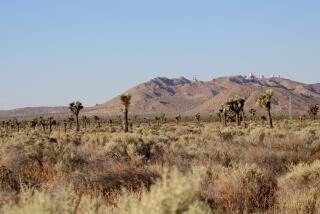Feds won’t prosecute wind farm if turbine blades kill a condor
- Share via
Federal wildlife officials on Friday for the first time agreed not to prosecute a developer if an endangered California condor is struck and killed by turbine blades at its proposed wind farm in the Tehachapi Mountains, about 100 miles north of Los Angeles.
In granting a right-of-way, the U.S. Bureau of Land Management, with approval of the U.S. Fish and Wildlife Service, will shield Alta Windpower Development from prosecution if a condor is fatally injured at its 2,300-acre site near the high-desert town of Mojave during the projected 30-year lifetime of the project.
The Fish and Wildlife Service believes that the likelihood of a condor being killed at the 153-megawatt project, a subsidiary of Terra-Gen Power, is low because site is outside the bird’s historic range and on the leeward slopes all but devoid of thermal updrafts the majestic scavengers with 10-foot wingspans need to gain altitude and soar.
Also, Terra-Gen plans to install a detection system designed to switch off its 456-foot-tall turbines when condors are spotted nearby. Terra-Gen voluntarily reduced the size of the project from 106 turbines to 51 spread across 4 square miles of mostly BLM land to minimize effects on wildlife, including golden eagles.
The detector is to include a telemetry system to track signals from radio transmitters attached to condors flying within 16 miles of the facility, radar to detect untagged birds and on-site biologists to report condor sightings. If a condor ventures within 2 miles, the speed of rotating turbine blades will be reduced from 150 mph to 15 mph within two minutes, and down to 3 mph a few minutes after that, Terra-Gen officials said.
“This project is leading the way in condor-avoidance systems,” said Randy Hoyle, head of wind and solar development for Terra-Gen. “But if there were a strike, there would be serious repercussions for us including an immediate halt to daytime operations and required development of additional measures to avoid further threats.”
Terra-Gen intends to share its detection data with other wind farms in the area, a wind energy hot spot in eastern Kern County bristling with thousands of turbines that have been in operation for decades, to enhance condor avoidance. The company said it will also provide $100,000 per year for the life of the project to condor recovery efforts.
Steve Henry, the Fish and Wildlife Service’s deputy field supervisor in Ventura, said the agreement with Terra-Gen “sets a standard for other wind energy facilities” and “provides condors with more protections than they have right now.”
“We are encouraging other companies to work with us to achieve a permit,” he added. “Without that in place, condors are at greater risk.”
Federal law prohibits the harassment or killing of endangered species for any reason. Penalties for killing a condor include up to $100,000 in fines and a year in imprisonment for an individual, and up to $200,000 in fines for an organization.
“For wind energy companies, that means if a condor is killed at one of their facilities they will be investigated and likely be prosecuted,” Jill Birchell, Fish and Wildlife Service special agent in charge for California and Nevada.
Some environmentalists said they worry that the agreement will weaken the concept of federal protections for endangered species and their crucial habitats.
“The California condor is a flagship species of the Endangered Species Act,” said Kelly Fuller, wind campaign coordinator for the American Bird Conservancy. “If taking a condor is allowed, what won’t be allowed?”
Tens of millions of dollars have been spent over the last three decades on condor recovery efforts led by the Fish and Wildlife Service, including captive breeding programs funded by private donors and organizations including the Los Angeles Zoo and the San Diego Zoo Safari Park.
Today, there are as many condors in the wild as there were in the 1950s. However, condor recovery programs have made the 138 free-flying condors in California reliant on humans for food free of contamination from lead ammunition. Condors born and bred in captivity and released into the wild must be trapped, then tested and treated for lead poisoning.







